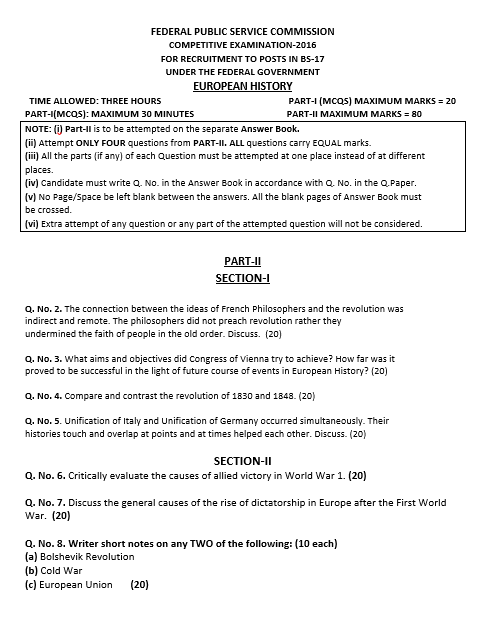Table of Contents
ToggleSECTION-I
No. 2. The connection between the ideas of French Philosophers and the revolution was indirect and remote. The philosophers did not preach revolution rather they undermined the faith of people in the old order. Discuss. (20)
No. 3. What aims and objectives did the Congress of Vienna try to achieve? How far was it proved to be successful in the light of the future course of events in European History? (20)
No. 4. Compare and contrast the revolution of 1830 and 1848. (20)
No. 5. The Unification of Italy and the Unification of Germany occurred simultaneously. Their histories touch and overlap at points and at times help each other. Discuss. (20)
SECTION-II
No. 6. Critically evaluate the causes of Allied victory in World War 1. (20)
No. 7. Discuss the general causes of the rise of dictatorship in Europe after the First World War. (20)
No. 8. Writer short notes on any TWO of the following: (10 each)
- Bolshevik Revolution
- Cold War
- European Union
Summaries of Questions:
No. 2: The connection between the ideas of French Philosophers and the revolution was indirect and remote. The philosophers did not preach revolution rather they undermined the faith of people in the old order. Discuss.
The French philosophers, such as Voltaire and Rousseau, did not directly call for a revolution but questioned the existing political and social systems. Their ideas led people to challenge authority and the monarchy, weakening their belief in the old order. This philosophical shift created a foundation for the French Revolution, although their teachings were more focused on reform than outright rebellion.
No. 3: What aims and objectives did the Congress of Vienna try to achieve? How far was it proved to be successful in the light of the future course of events in European History?
The Congress of Vienna aimed to restore stability in Europe after the Napoleonic Wars by establishing a balance of power and restoring monarchies. It sought to prevent further revolutions and maintain peace. While it temporarily succeeded in maintaining order, it failed to address nationalist movements, leading to future conflicts and revolutions in Europe.
No. 4: Compare and contrast the revolution of 1830 and 1848.
Both the 1830 and 1848 revolutions were driven by dissatisfaction with the political system and social conditions, but they had different causes and outcomes. The 1830 revolution in France was sparked by the monarchy’s actions and led to the July Monarchy, while the 1848 revolution was part of a broader wave of uprisings across Europe. The 1848 revolution was more widespread but ultimately failed to bring lasting change.
No. 5: The Unification of Italy and the Unification of Germany occurred simultaneously. Their histories touch and overlap at points and at times help each other. Discuss.
The unifications of Italy and Germany were both driven by nationalist movements in the 19th century. Though the countries had different leaders and methods, their paths were intertwined. Italy’s unification was influenced by the efforts of leaders like Cavour, while Germany’s unification was largely the result of Bismarck’s political maneuvers. Both processes impacted each other and reshaped the European balance of power.
No. 6: Critically evaluate the causes of Allied victory in World War 1.
The Allied victory in World War I was influenced by several factors, including superior resources, effective military strategies, and the involvement of the United States, which provided crucial support. The Central Powers faced internal struggles and exhaustion, while the Allies had stronger coordination and morale, leading to their eventual victory.
No. 7: Discuss the general causes of the rise of dictatorship in Europe after the First World War.
After World War I, Europe experienced economic instability, social unrest, and the disillusionment of many with traditional political systems. These conditions led to the rise of dictatorships, as people sought strong leadership in the face of economic crises and fear of communism. Leaders like Mussolini and Hitler capitalized on these issues to establish authoritarian regimes.
No. 8: Write short notes on any TWO of the following: (10 each)
- Bolshevik Revolution: The Bolshevik Revolution, led by Lenin in 1917, overthrew the Russian monarchy and established a communist government. It marked the beginning of the Soviet Union and was a key event in the rise of global communism.
- Cold War: The Cold War was a period of tension between the United States and the Soviet Union after World War II, characterized by political, military, and ideological rivalry. It involved proxy wars and an arms race but never escalated into direct military conflict between the two superpowers.
- European Union: The European Union (EU) is a political and economic union of European countries established to promote economic cooperation, stability, and peace. It grew out of the post-WWII desire to prevent further conflict and has evolved into a major global economic and political entity.
